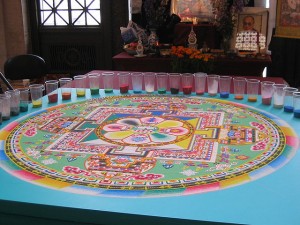
A mandala is a twofold meditation tool. The process of creating it is meditative, and it can be used as a focus for meditation once it has been created.
The idea of the mandala comes from Hindu and Buddhist tradition. The mandala is a diagram of the sacred cosmos. Tibetan Buddhist sand mandalas depict temples and palaces where particular Buddhas dwell, and pathways between them. A sand mandala is carefully and painstakingly constructed by pouring sand through special pointy tubes onto a surface, and after a certain amount of time, the sand is swept up and poured out as a blessing into a river, or given away to pilgrims.
Mandalas can also be drawn or painted. Carl Gustav Jung (the psychoanalyst) drew mandalas representing his inner states, and encouraged his clients to do the same. Other Jungians also did this. Drawing a mandala can be a very satisfying experience – it doesn’t have to be great art; it’s the process of creating a picture of your inner world that is important. You can also make mandalas from seeds, pebbles or shells.
Once you have created your mandala, you can use it as a focus for meditation, following the patterns you have created, or meditating on the meaning of the symbols within the mandala. In Buddhism, sand mandalas are deliberately made to be impermanent, and the sand is swept up and offered to a nearby river.
(This post was originally published on UK Spirituality.)
















